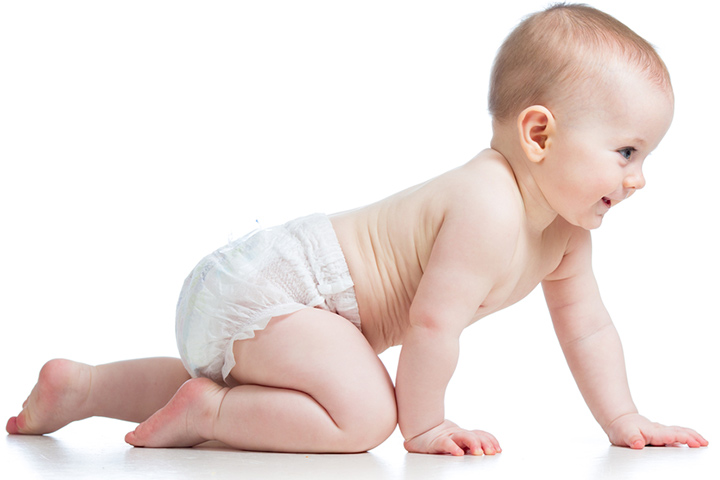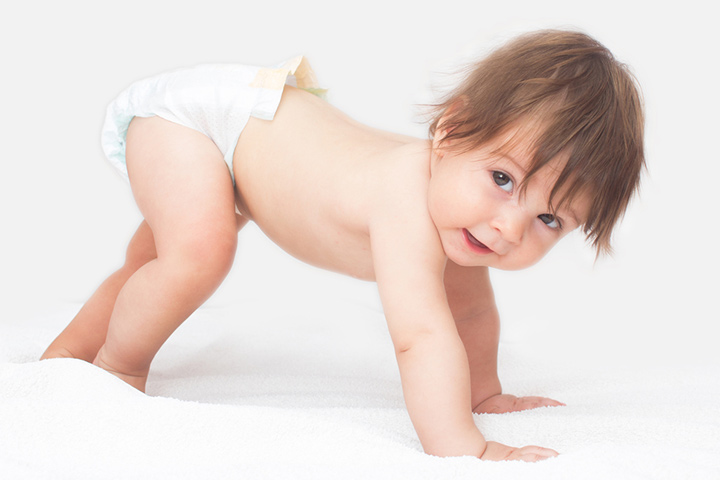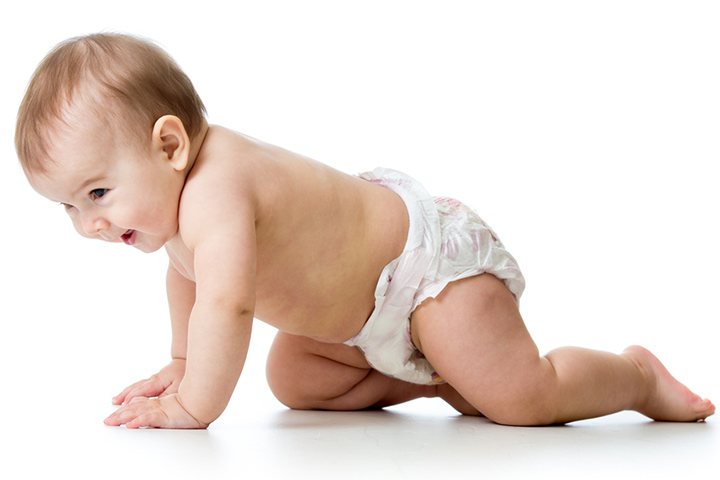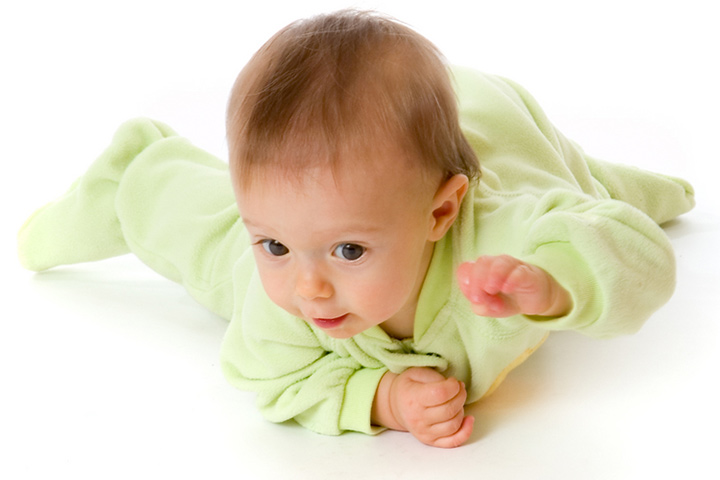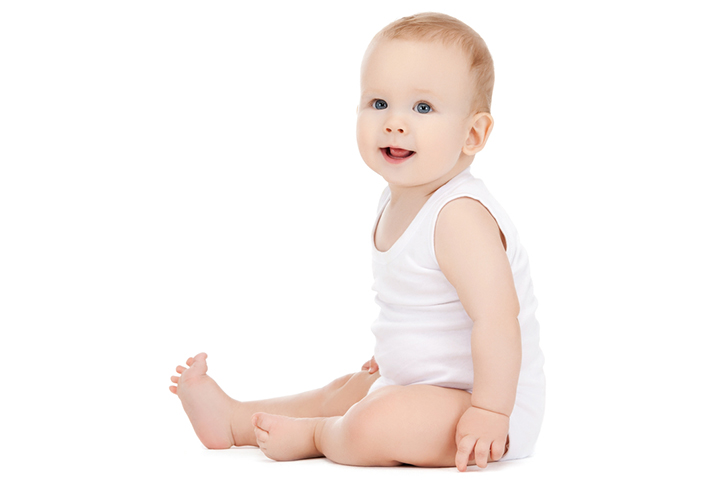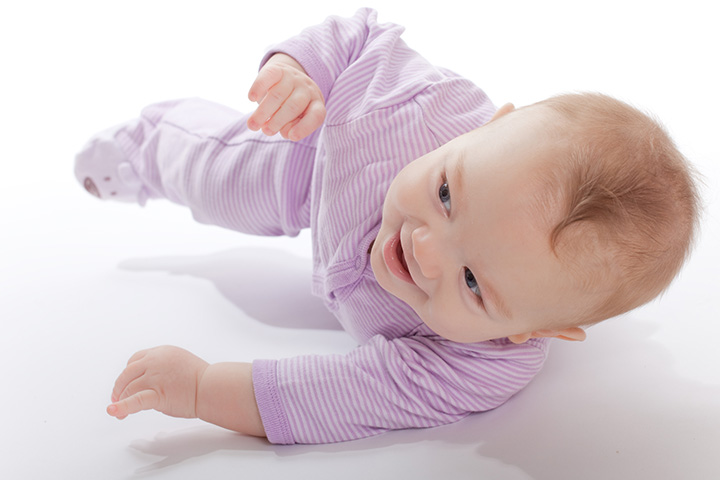When your baby is crawling, you are more excited than them! Crawling is a significant developmental milestone as it is an early step towards infant mobility. Babies use crawling as means to explore and understand the world around them.
But not all babies crawl at the same age. To help you understand that and more, this MomJunction post gives you the information about crawling in babies and methods to stimulate it.
When Do Babies Crawl?
The average age when most infants begin to crawl is nine months (1). While some infants achieve it sooner in seven months, others attain this skill by their first birthday. In either case, crawling does not happen overnight, and there are a series of steps or stages that lead to crawling. In the early stages, your baby may start by scooting, wriggling, or shuffling on their stomach. Encourage this movement by placing toys just out of reach, so your baby has to work to reach them.
How Do Babies Learn To Crawl?
Crawling is a gradual process, where an infant goes through several stages.
- Stage one – holds head up at two months: The first step towards crawling is the ability to hold the head up when lying on the tummy. A baby attains the skill at the age of two months when neck muscles have the strength to work against gravity (2).
- Stage two– pushes elbows at four months: Once the infant has achieved lifting the head up, he experiments with his arms. During tummy time, the little one pushes the elbows to the ground to lift the torso (3).
- Stage three – supports body weight at six months: Once six months old, the baby pushes the body up from the ground and supports its weight on all fours limbs (hands and knees of the legs). It is almost like getting into the crawling position. Six months is also when the baby starts to sit independently and roll over (4).
- Stage four – creeping at eight months: Creeping means pulling the body forward using arms while the tummy and legs drag along (5). The movement is a sign that the baby is ready to crawl (6).
- Stage five – crawling around nine months: The baby has the muscular dexterity to move the body using all four limbs. It means the baby is now all set to crawl.
Crawling can be of different types as not all babies crawl the same way. Each style has a unique technique.
What Are The Different Types Of Baby Crawls?
A baby may stick to one of the following methods or alternate among them:
1. Cross crawl:
It is the usual crawling style where the baby bears weight on hands and knees, moving an arm and opposite knee simultaneously to move forward. This method is also called classic crawl and classic hands-and-knees.
2. Bear crawl:
It is the same as cross crawl, with the only difference being that the baby stretches his legs straight and crawls forward on feet, like bears, instead of knees.
3. Crab crawl:
Similar to cross crawl, the difference here is that the infant moves the body backward or sideways while in crawling position before launching the body forward with his hands.
4. Commando crawl:
The baby’s tummy touches the ground, while he alternately moves an opposite arm and leg. Since the form of crawling resembles the one taught to soldiers, it is referred to as commando crawling, army crawl, and military crawl. It is also called belly crawl and tummy crawl since the stomach is lower and touches the ground.
Besides the above crawling methods, the baby may also use some unconventional forms of movement.
Other forms of baby movement
Babies have some unusual ways of moving that are categorized as a variation of crawling, but do not resemble true crawling:
- Bottom scooter:
The baby gets into a sitting position, resting his bottom on the ground. He then uses the arms to push the body forward while in the seated position.
- Rolling crawl:
The infant simply rolls to move from one place to another.
The last two methods may seem unbelievable and perhaps comical, but these are all considered normal forms of infant crawling movement by the American Academy of Paediatrics (AAP) (7).
Breast crawl – Is it a type of crawling?
Some parents may have heard of “breast crawl”, also called chest crawl. This is not a type of crawling but is a slow, creeping movement a newborn makes towards breasts immediately after birth, when placed on the mother’s abdomen or chest (8). Therefore, breast crawl is not a form of infant movement but an early display of crawling reflex. It is a natural instinctive movement of a baby to find the nipple and initiate the first breastfeed. Since it happens right after birth, it is also called birth crawl and breastfeeding crawl.
Crawling as a mode of movement is a significant milestone, and there are ways to initiate it in babies.
[ Read: Physical Activities For Toddlers ]
How To Help A Baby Crawl?
Encouraging a baby to crawl can be done easily at home. The below tips can help.
- Have regular tummy time as it is a single activity with multiple benefits. It strengthens almost every muscle in the baby’s body, paving way for complex movements such as crawling. AAP recommends two to three sessions of tummy time play every day with each session lasting for at least five minutes (9). As the infant grows, increase tummy time. Addie Dwyer, a working mother and Youtuber from the Midwest, says, “You could also put them (infants) on their back with a little towel rolled up under their bum and that will encourage them to put their feet to their hands strengthening those key muscle groups (i).”
- Work on the infant’s curiosity and encourage them to reach for objects. This inquisitiveness can be leveraged to improve their motor skills. Parents can place objects around the baby and then encourage the little one to reach for them. It creates a strong intent for the baby to move their body, thus stimulating crawling. You can also place pillows or cushions in their path to encourage them to work on dragging, inching, or slithering over them.
- Get him to sit as sitting helps improve the supporting capabilities of the back muscles. Once the baby is six months old, place him in a sitting position and let him stay that way for a few minutes. Repeat the activity every day.
- Creeping is important too, even if it may seem awkward to see the baby creep around the house! Nevertheless, the creeping movement helps the baby learn to move forward and is vital for creating a foundation for subsequent crawling skills of the infant.
- Make crawling interesting for the baby, once the baby is a full-fledged crawler. Hiding toys or playing peek-a-boo ensure that the infant crawls a lot. If at any moment the baby stumbles and falls, just give him a reassuring hug and let him go back to crawling.
Various activities can help in motivating different stages of crawling development.
Exercises To Help A Baby Crawl
Each activity stimulates a specific pre-crawling stage thus encouraging the baby to crawl:
1. What’s that?
Age to play: Two months
Stimulates: Pre-crawling stage one – holding head up
How to:
- Put the infant on his tummy and sit in front of him with his favorite toy or rattle.
- Shake the rattle gently to get the baby’s attention. The baby invariably raises his head to take a good look at the object.
- Move the rattle around in a horizontal plane. At two months, infants can follow the path of a moving object of interest within their field of vision (2).
- Watching the rattle move around helps strengthen the baby’s neck muscles.
2. Reach for the toy:
Age to play: Four months
Stimulates: Pre-crawling stage two – pushing elbows
How to:
- Put the baby on his tummy and put some toys around the little one. The toys should be within reach.
- Encourage the infant to pick up the toys. Since the baby is on the tummy, he will put his weight on one elbow to use the other hand to hold the toy. It helps strengthen the arm muscles to bear the body weight better.
- Place the toys around each arm so that the infant alternates between elbows of both arms to support body weight.
Dwyer also believes that toys are a great way to teach crawling to children, and parents can incorporate them in various ways to make learning more enjoyable. She says, “You can put a toy up on a cushion, pillow, mat, or something that it raises like a little ledge or a toy shelf. You could also put a magnet or a squeegee on the fridge or a mirror or just hold something and put them over your leg (i).”
3. Assisted crawling position:
Age to play: Six months
Stimulates: Pre-crawling stage three – supporting body weight
How to:
- At six months, the baby can at least support the body weight on all fours, which means he can get into a crawling position (4).
- Put the baby in the crawling position. Now take a soft towel, roll it to make a rope, and gently pass it around the chest of the baby. Hold the two loose ends of the towel firmly on the top.
- The towel acts as a harness that supports the baby to stay longer in the crawling position thus strengthening the leg and arm muscles to hold the body weight longer.
- Place the baby’s favorite toys in front of him to play in the crawling position. Hold the baby for three to five minutes initially, and gradually increase the time spent on the exercise as the baby gets older.
4. Follow the moving toy:
Age to play: Eight months
Stimulates: Pre-crawling stage four – creeping
How to:
- Tie a car to a string and put it in front of the baby, who is on his tummy.
- Slowly pull the car away from the baby while encouraging him to follow it.
- The baby will start creeping towards the moving toy to catch it. Play the game regularly once the infant begins to creep.
5. Crossing the tunnel:
Age to play: Nine months
Stimulates: Stage five – crawling
How to:
- Buy a small toy tunnel made of nylon. Ensure the mouths of the tunnel are broad enough to accommodate the baby.
- Put toys at one end of the tunnel and the baby at the other end.
- Show the toys to the baby and encourage him to reach out to them. The baby will crawl through the tunnel to the other end.
- Repeat the activity by making your partner call the baby from one end of the tunnel prompting the baby to crawl through it again.
Maintain a regular schedule of these activities as they come with several advantages and help you achieve the best results.
Benefits Of Crawling
Crawling is beneficial in multiple ways (10):
- Strengthens muscles: Since the baby needs to exert a coordinated force to move the body, his muscles eventually become stronger. Crawling strengthens the muscles of shoulders, arms, and back. It also makes the muscles of the abdomen and hips firmer.
- Improves posture and balance: Greater strength leads to improved posture. Parents also notice that since their infants start crawling, they balance their body better and appear less wobbly.
- Makes joints more flexible: There is an extended range of motion and flexibility in joints from those of the spine to the wrist and the ankles.
- Brain development: All the exploration through crawling upgrades the neuron functions and accelerates brain development.
- Vision development: Babies use their eyes as a guide to navigate around their surroundings while crawling. This leads to a better eye-body coordination. Crawling thus helps in vision development, specifically improving binocular vision (depth perception).
- Better body structure: All that weight bearing on the hands improves the shape of the hand. A better-shaped hand eventually leads to better grip.
It is possible for the baby to wander off in his zeal to explore. So, parental involvement in crawling does not end with just assistance. Besides being watchful about the baby, there are many things you could do to ensure the safety of the baby.
How To Make Crawling Safe For The Baby?
Parents can make crawling a safe developmental activity for the baby by following these simple tips.
- Start with a soft surface: When you notice the baby creeping for the first time, place him on a cushioned surface that will absorb the impact of injury or fall.
- Baby-proof the house: Prepare the house to be safe for the baby to crawl around. Start by blocking the staircases with sturdy gates taller than the baby and with slats/ridges narrow enough to prevent the baby to pass through them. Secure shelves and racks firmly to the wall or the ground to prevent them from falling on the baby. Tie a piece of padding to sharp edges of furniture. Wrap any loose electrical cords and cover electricity plug outlets.
- Buy cribs with guard rails: The baby must always sleep in a crib that has guard rails with narrow spacing to prevent him from slipping out. When buying a play yard, choose ones that have a vertical net to stop the baby from toppling. Parents often complain of their baby crawling out of the crib, which is common as infants cannot yet judge a dip or fall. But, the judgment improves after about six weeks into crawling. Nevertheless, it is best to put the baby for naps only in a crib with guard rails.
- Do not leave the baby unattended: Despite all the safety measures, never leave a baby unattended. While crawling, a baby may lose track of the path and accidentally crawl out of open doors while shutting them behind. Maintaining a vigil is perhaps the best way to prevent any accidents.
Safety of the baby is vital when he is crawling. But sometimes the baby may not crawl at all.
What If The Baby Does Not Crawl?
Before you panic, here is what you should know:
- Some babies take time: The earliest the baby can crawl is at six months. And, infants have a crawling age range of six to twelve months (11). Each baby has a unique developmental timeline, and as long as he is growing normally, there is no need to panic. Parents can rather be patient and stimulate crawling through activities such as the ones mentioned earlier.
- Premature babies may crawl later: A premature infant usually has delayed development, when compared to a full-term infant (6). Regular checkups by a doctor help ensure that a preemie achieves all the milestones even if delayed. Some babies may take longer than others to master crawling, so don’t worry if your baby is still squirming or not crawling at all.
- NeonataliXFirst four weeks of a baby’s life infections may delay development: Suffering infectious diseases early in life may affect the various developmental milestones of an infant (12). For instance, a lung disease called bronchopulmonary dysplasiaiXA chronic lung disease in newborns and premature babies that affects the airways, lungs, and air sacs of the lungs (BPD) impacts the baby’s posture to the extent that the little one is unable to sit independently. It subsequently influences the ability to crawl by impeding its achievement.
- Neurological problems can delay crawling: Certain genetically caused neurological problems, such as autismiXA neurological and developmental disorder that may impact the way a baby socially interacts, communicates, and learns, cerebral palsyiXMotor disability caused by defective brain development, causing impaired movement, balance, and posture, Down syndromeiXA genetic condition characterized by unusual facial features, and speech and language problems due to an extra chromosome, and Rett syndromeiXA rare genetic neurological disorder causing issues with coordination, learning, communication, and language, mostly seen in girls, may delay or interfere with crawling (13) (14). Most infants are screened for these conditions at regular intervals to ensure early detection and intervention. Babies with these neurological disorders display other symptoms that can be noticed by a doctor during a routine examination.
Spotting any sign of developmental delay is thus crucial. Keep reading to find out these red flags.
Red flags in baby’s development
Here are the signs of delay in a baby’s development that affect the ability to crawl later:
- At two months: Cannot hold head up when placed on the tummy
- At four months: Does not hold steady and does not bring hands to mouth
- At six months: Does not roll over and has stiff muscles
- At nine months: Does not sit by himself
Take the baby to a pediatrician if you notice these developmental delays. However, developmental anomalies need not always be the reason. The baby might just choose to walk rather than crawl!
Can Babies Walk Before They Crawl?
Yes, some babies may skip crawling and get straight on their feet and walk. Here are the essential points to keep in mind about it.
- It is less common: A baby cannot support the entire body weight on his legs if he never supported them on his knees. It is relatively rare to find infants who skip crawling as it is a natural intermediary milestone before walking. A study that analyzed walking in infants found that even the youngest infants who walk wobbly have crawled at some point in their infancy. There is always a gradual upgrade from crawling to walking.
- Skipping crawling is said to have side-effects: Some experts believe that giving crawling a pass in favor of walking could have its down points. For instance, the American Optometric Association (AOA) states that infants who do minimal crawling and adopt early walking tend to have poor vision-movement coordination (15) and lack improved muscle strength. However, these adverse effects are rare, which brings us to the next point.
- It is still normal: Despite all the anxiety associated with skipping crawling, most experts believe it is entirely normal for an infant to do so (16). Most pediatricians firmly believe that it is completely okay for a baby to walk before crawling as long as he achieves other developmental milestones (17). Precocious infants could begin a month with crawling and end it with walking. Such situations should not be alarming. Interestingly, about 40% of infants in the US skipped crawling in the early 20th century due to long clothing that hindered crawling. These babies went on to grow normally without any developmental hiccups.
Parents are often concerned if they do not find their babies crawling at about nine months. Though crawling is vital for the baby’s development, it is normal for some babies to take longer to achieve this milestone. It is best to let the infant take his course of development.
Babies may exhibit cross, bear, crab, or commando crawl. You can help your baby crawl by getting him to sit, allowing tummy time, and encouraging them to reach objects. They will have fun while they are scooting, wriggling, shuffling, dragging, inching, slithering, and squirming their way towards this important milestone. Ensure that the room is baby-proof, and consult a doctor if you suspect any developmental delays.
Key Pointers
- Babies can learn to crawl as early as seven months, but most can do so by one year.
- Different types of crawls that babies use include cross, bear, crab, command, bottom scooter, and rolling crawls.
- Parents can encourage their babies to crawl by giving them regular tummy time, encouraging them to reach for objects, and including fun games.
- Crawling can strengthen babies’ muscles, improve posture, balance, body structure and flexibility, and brain and vision development.
- If parents notice any developmental delays in their babies’ crawling, they should consult with a pediatrician.
Learn how to help your baby develop their crawling skills in 5 easy steps! Get tips on baby exercises, activities and development for 6-9 month olds.

